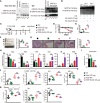Secreted glucose regulated protein78 ameliorates DSS-induced mouse colitis
- PMID: 36776831
- PMCID: PMC9909966
- DOI: 10.3389/fimmu.2023.986175
Secreted glucose regulated protein78 ameliorates DSS-induced mouse colitis
Abstract
The secreted form of 78-kDa glucose-regulated protein (sGRP78) has been widely reported for its property in aiding resolution of inflammatory. However, little is known on its potential in the treatment of colitis. To investigate the expression pattern and functional outcome of GRP78 in ulcerative colitis, its expression was measured in human and murine colitis samples. It was found that GRP78 was spontaneously secreted to a high level in gut, which is a physiological site of immune tolerance. During the active phase of DSS-induced colitis, the sGRP78 level was significantly reduced but rebounded quickly during resolving phase, making it a potential candidate for the treatment of colitis. In the following experiments, the administration of sGRP78 was proved to decrease susceptibility to experimental colitis, as indicated by an overall improvement of intestinal symptoms, restoration of TJ integrity, decreased infiltration of immune cells and impaired production of inflammatory cytokines. And specific cleavage of endogenous sGRP78 could aggravate DSS colitis. Adoptive transfer of sGRP78-conditioned BMDMs reduced inflammation in the gut. We linked sGRP78 treatment with altered macrophage biology and skewed macrophage polarization by inhibiting the TLR4-dependent MAP-kinases and NF-κB pathways. Based on these studies, as a naturally occurring immunomodulatory molecule, sGRP78 might be an attractive novel therapeutic agent for acute intestinal inflammation.
Keywords: DSS; immunomodulatory; macrophage; sGRP78; ulcerative colitis.
Copyright © 2023 Zhao, Lv, Zhou, Guo, Li, Guo, Liu, Tu, Zhu, Tao, Shen, He and Lei.
Conflict of interest statement
The authors declare that the research was conducted in the absence of any commercial or financial relationships that could be construed as a potential conflict of interest.
Figures







Similar articles
-
Anneslea fragrans Wall. ameliorates ulcerative colitis via inhibiting NF-κB and MAPK activation and mediating intestinal barrier integrity.J Ethnopharmacol. 2021 Oct 5;278:114304. doi: 10.1016/j.jep.2021.114304. Epub 2021 Jun 8. J Ethnopharmacol. 2021. PMID: 34116185
-
Sanhuang Xiexin decoction ameliorates DSS-induced colitis in mice by regulating intestinal inflammation, intestinal barrier, and intestinal flora.J Ethnopharmacol. 2022 Oct 28;297:115537. doi: 10.1016/j.jep.2022.115537. Epub 2022 Jul 14. J Ethnopharmacol. 2022. PMID: 35843414
-
Mesona chinensis Benth Polysaccharides Alleviate DSS-Induced Ulcerative Colitis via Inhibiting of TLR4/MAPK/NF-κB Signaling Pathways and Modulating Intestinal Microbiota.Mol Nutr Food Res. 2022 Aug;66(15):e2200047. doi: 10.1002/mnfr.202200047. Epub 2022 Jun 17. Mol Nutr Food Res. 2022. PMID: 35661585
-
Glycyrrhiza uralensis Fisch. alleviates dextran sulfate sodium-induced colitis in mice through inhibiting of NF-κB signaling pathways and modulating intestinal microbiota.J Ethnopharmacol. 2022 Nov 15;298:115640. doi: 10.1016/j.jep.2022.115640. Epub 2022 Aug 24. J Ethnopharmacol. 2022. PMID: 36030029
-
Xianglian Pill attenuates ulcerative colitis through TLR4/MyD88/NF-κB signaling pathway.J Ethnopharmacol. 2023 Jan 10;300:115690. doi: 10.1016/j.jep.2022.115690. Epub 2022 Sep 6. J Ethnopharmacol. 2023. PMID: 36075274
Cited by
-
Sedanolide alleviates DSS-induced colitis by modulating the intestinal FXR-SMPD3 pathway in mice.J Adv Res. 2025 Mar;69:413-426. doi: 10.1016/j.jare.2024.03.026. Epub 2024 Apr 4. J Adv Res. 2025. PMID: 38582300 Free PMC article.
-
Essential roles of the unfolded protein response in intestinal physiology.eGastroenterology. 2024 Dec 31;2(4):e100129. doi: 10.1136/egastro-2024-100129. eCollection 2024 Oct. eGastroenterology. 2024. PMID: 39944266 Free PMC article. Review.
-
CD14loCD301b+ macrophages gathering as a proangiogenic marker in adipose tissues.J Lipid Res. 2025 Jan;66(1):100720. doi: 10.1016/j.jlr.2024.100720. Epub 2024 Dec 5. J Lipid Res. 2025. PMID: 39645040 Free PMC article.
-
Mesalazine alleviated the symptoms of spontaneous colitis in interleukin-10 knockout mice by regulating the STAT3/NF-κB signaling pathway.World J Gastroenterol. 2025 Feb 21;31(7):96459. doi: 10.3748/wjg.v31.i7.96459. World J Gastroenterol. 2025. PMID: 39991681 Free PMC article.
-
Endoplasmic Reticulum Stress in Cancer.MedComm (2020). 2025 Jun 19;6(7):e70263. doi: 10.1002/mco2.70263. eCollection 2025 Jul. MedComm (2020). 2025. PMID: 40547943 Free PMC article. Review.
References
Publication types
MeSH terms
Substances
LinkOut - more resources
Full Text Sources
Medical
Miscellaneous

